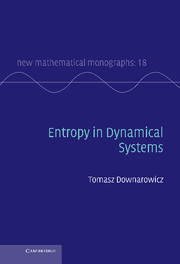Book contents
- Frontmatter
- Contents
- Preface
- Introduction
- PART I Entropy in ergodic theory
- PART II Entropy in topological dynamics
- 6 Topological entropy
- 7 Dynamics in dimension zero
- 8 The entropy structure
- 9 Symbolic extensions
- 10 A touch of smooth dynamics*
- PART III Entropy theory for operators
- Appendix A Toolbox
- Appendix B Conditional S–M–B
- List of symbols
- References
- Index
9 - Symbolic extensions
from PART II - Entropy in topological dynamics
Published online by Cambridge University Press: 07 October 2011
- Frontmatter
- Contents
- Preface
- Introduction
- PART I Entropy in ergodic theory
- PART II Entropy in topological dynamics
- 6 Topological entropy
- 7 Dynamics in dimension zero
- 8 The entropy structure
- 9 Symbolic extensions
- 10 A touch of smooth dynamics*
- PART III Entropy theory for operators
- Appendix A Toolbox
- Appendix B Conditional S–M–B
- List of symbols
- References
- Index
Summary
Given a topological dynamical system (X, T, S) of finite entropy, we are interested in computing the “amount of information” per unit of time transferred in this system. Suppose we want to compute verbatim the vertical data compression, as described in the Introduction (Section 0.3.5): the logarithm of the minimal cardinality of the alphabet allowing the system to be losslessly encoded in real time. Since we work with topological dynamical systems, we want the coding to respect not only the measurable, but also the topological, structure. There is nothing like the Krieger Generator Theorem in topological dynamics. A topological dynamical system of finite entropy (even invertible) need not be conjugate to a subshift over a finite alphabet. Thus, we must first create its lossless digitalization, which has only one possible form: a subshift, in which the original system occurs as a factor. In other words, we are looking for a symbolic extension. Only then can we try to optimize the alphabet. It turns out that such a vertical data compression is not governed by the topological entropy only by a different (possibly much larger) parameter.
What are symbolic extensions?
First of all, notice that if a system has infinite topological entropy, it simply does not have any symbolic extensions, as these have finite topological entropy. We do not accept extensions in form of subshifts over infinite alphabets, even countable, like ℕ0∪ ∞.
Information
- Type
- Chapter
- Information
- Entropy in Dynamical Systems , pp. 272 - 302Publisher: Cambridge University PressPrint publication year: 2011
